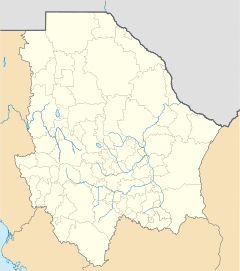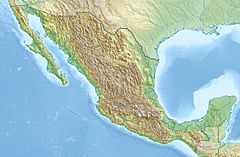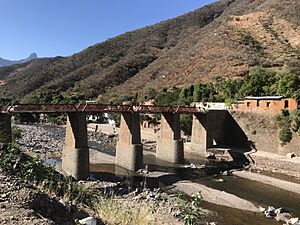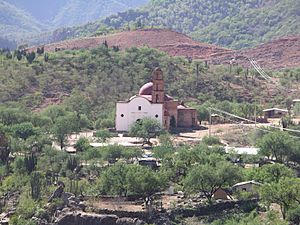Batopilas, Chihuahua facts for kids
Quick facts for kids
Batopilas
|
|
|---|---|
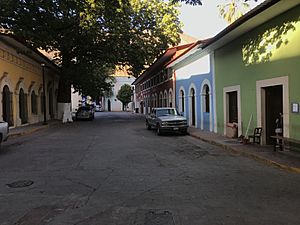
A street of the main plaza (2017)
|
|
| Country | |
| State | Chihuahua |
| Municipality | Batopilas |
| Foundation | 1708 |
| Elevation | 578 m (1,896 ft) |
| Population
(2010)
|
|
| • Total | 1,220 |
| • Demonym | Batopilense |
| Time zone | UTC-7 (MST) |
| • Summer (DST) | UTC-6 (MDT) |
| Postal Code |
33400
|
| Area code(s) | 649 |
Batopilas is a small town in the Mexican state of Chihuahua. It sits at the bottom of the Batopilas Canyon, which is part of the famous Copper Canyon. The Batopilas River flows through the town. In 2010, about 1,220 people lived here. The town is located 578 meters (1,896 feet) above sea level in a narrow valley.
Mexico's government named Batopilas a "Pueblo Mágico" (Magical Town) in 2012. This means it's a special place known for its natural beauty, cultural richness, or historical importance. Batopilas was once a very important center for silver mining, from the early 1700s to the early 1900s.
Contents
What Does Batopilas Mean?
The native people of this area, the Rarámuri (also called Tarahumara) Indians, called the region "Bachotigori." This means "Place of the enclosed waters." They used this name to describe the canyon with its many plants and animals. "Batopilas" is a Spanish version of this original Rarámuri word.
A Look Back at Batopilas's History
The Rarámuri people probably knew about silver in the area long before Spanish explorers arrived. Around 1632, a Spanish explorer found pure white silver ore in the Batopilas River. They named this mine the Nevada Mine, which means "snow-capped" in Spanish. Samples of this silver were sent to Mexico City and then to Spain.
Many old records of Batopilas were lost due to two big fires, one in 1740 and another in 1845. Most of what we know about the early days comes from documents in Spain.
The Spanish Era (1708-1821)
Batopilas officially started in 1708. That's when Pedro de la Cruz claimed a mine he called Guadalupe. As more mines were found, the town grew bigger and more important.
One of the most famous buildings was the Hacienda San Miguel. It was built in the mid-1600s across the river from the town. Don Juan José de Rivolta made it bigger in the 1740s, turning it into a castle with guard towers. Rivolta became very rich and powerful in Batopilas.
After Rivolta, Rafael Alonzo Pastrana took over the hacienda. He found many rich silver veins. Between 1730 and 1750, his "Pastrana vein" produced a huge amount of silver, making him one of the richest people in the world. He added more living areas and processing facilities to the hacienda. Later, Don Ángel Bustamante managed the Carmen mine, which produced over 30 million pesos worth of silver from 1790 to 1820.
After these rich times, and after the Mexican War of Independence (1810–1821), Batopilas became less important. By 1840, only about 10 families remained in the town.
American Investments (1861-1921)
Batopilas started to recover when Manuel Mendazona, a merchant, arrived in 1852. He bought and fixed up Hacienda Pastrana. He reopened old mines and started a new tunnel in 1854. Sadly, Mendazona died in 1856. His brother-in-law continued the work for five years. Then, in 1861, he sold the mines to an American investor named John R. Robinson.
John Robinson's Time (1861-1879)
John Riley Robinson was a doctor and inventor. He partnered with wealthy investors from Wells Fargo to buy silver mines in Mexico. In 1861, Robinson bought the San Miguel mines and hacienda, and the San Antonio complex. These properties became part of the Batopilas Silver Manufacturing Co. in 1862.
Robinson was a smart businessman. He made small changes to improve how the mines worked. The town of Batopilas grew, attracting people from Mexico, America, and even China, all looking for work. While the company and its owners became very rich, most local people remained poor.
In the 1860s and 1870s, silver was sent to Mazatlán and then shipped to places like San Francisco or New York City. Mexico didn't get taxes from this. So, in 1872, the Mexican President made the company send all silver to a new mint in Chihuahua City.
Robinson faced many challenges, including political problems in Mexico. He also lost his two sons and two grandchildren to illness. In 1876, he decided to sell the company. In 1879, he sold it to a group led by Alexander Shepherd for $600,000.
Under Robinson, Batopilas began to thrive again. In 1877, it became the center of a new region called Canton Andrés del Río. It's thought that about $3,000,000 worth of silver was taken out during Robinson's time.
Alexander Shepherd's Time (1879-1921)
After buying the mines, Alexander Shepherd and his partners had big plans. They brought in important people, including a U.S. Senator, to help. They also made friends with powerful Mexicans like Porfirio Díaz, who later became president.
Shepherd took strong control in Batopilas. He replaced local officials with people loyal to him. He changed how workers were paid and increased security. He also stopped most banditry around the town. The main mine tunnel was extended and named the Porfirio Díaz tunnel. A new bridge was built to bring ore to the processing plant, and new machines were installed. By 1883, the company had produced a huge amount of refined silver.
Shepherd used his friendship with President Díaz to gain control of a vast area of land, including ranches, forests, and mining rights. The company was also excused from most taxes for 20 years, a deal that was later renewed. Shepherd even secretly smuggled silver south through Mazatlán.
In 1887, Shepherd created the Batopilas Consolidated Mining Company, which included many mines. The town's population grew to over 6,500 people. However, silver prices began to fall, and the company had to cut jobs. By 1906, the town had only about 4,000 people.
Alexander Shepherd died in 1902. His son, Alexander Shepherd Jr., took over until the mines closed in 1921. After Shepherd's death, it was discovered that he had made some expenses seem much higher than they were.
Shepherd did improve the town in some ways. He built bridges, water systems, roads, and a hydroelectric plant. This plant gave Batopilas electricity, making it only the second city in Mexico (after Mexico City) to have it. He also improved medical care for miners. However, these improvements mainly helped the mining operations and the people at Hacienda San Miguel. Most miners earned very little and often got sick from working in unsafe conditions. Many died young from lung diseases.
The Mexican Revolution began in 1910. It was a time of great change and fighting. Many foreigners, especially Americans, had to leave their businesses in Mexico. It became very hard to transport silver safely. After the revolution, the government took control of many industries and lands. This led the owners of the Batopilas mines to close them in 1921.
After the Mines Closed (1921-Today)
After the American company left, the land was divided among the people of the canyons as part of Mexico's land reform. By the late 1990s, over 670,000 acres were given to families in the Batopilas area. Most of this land was only good for raising goats. In the 1980s, Batopilas was a top center for goat farming in Chihuahua.
Many people left Batopilas after the mines closed. By the mid-1930s, only about 400 people remained. The hydroelectric plant was destroyed in a big flood in 1940, and Batopilas had no electricity again until 1989.
In the 1940s, a one-lane dirt road was built connecting Creel to a nearby copper mine. Later, from 1975 to 1978, a road was built from this mine to Batopilas. This road finally connected the town to the outside world. In 2016, the road was widened and paved.
It's hard to know exactly how much silver was mined from Batopilas over the years. Some experts believe it produced seven times more silver than a famous mine in Norway! Today, very little mining happens in Batopilas, though some exploration still goes on.
Where is Batopilas?
Batopilas town is located along the Batopilas River, in the narrowest part of its canyon. It stretches about 5 kilometers (3 miles) along the river's right bank. The main way to get there is by a five-hour bus ride from Creel along the Batopilas Road.
From Batopilas, a dirt road goes to Satevó, about 5 kilometers (3 miles) away. This road was built by a mining company in 1990 and later extended.
Weather in Batopilas
Batopilas has a warm climate. It's often described as a hot, semi-arid (dry) area with hot summers and mild winters.
| Climate data for Batopilas, Chihuahua | |||||||||||||
|---|---|---|---|---|---|---|---|---|---|---|---|---|---|
| Month | Jan | Feb | Mar | Apr | May | Jun | Jul | Aug | Sep | Oct | Nov | Dec | Year |
| Record high °C (°F) | 34.5 (94.1) |
39.0 (102.2) |
40.0 (104.0) |
45.0 (113.0) |
45.5 (113.9) |
45.0 (113.0) |
44.0 (111.2) |
42.0 (107.6) |
44.0 (111.2) |
41.5 (106.7) |
37.0 (98.6) |
34.0 (93.2) |
45.5 (113.9) |
| Mean daily maximum °C (°F) | 24.5 (76.1) |
26.9 (80.4) |
29.3 (84.7) |
33.6 (92.5) |
37.1 (98.8) |
39.1 (102.4) |
34.5 (94.1) |
33.8 (92.8) |
34.4 (93.9) |
33.3 (91.9) |
29.2 (84.6) |
24.5 (76.1) |
31.7 (89.1) |
| Daily mean °C (°F) | 17.0 (62.6) |
19.1 (66.4) |
21.7 (71.1) |
25.5 (77.9) |
29.0 (84.2) |
31.6 (88.9) |
28.6 (83.5) |
28.3 (82.9) |
28.0 (82.4) |
26.0 (78.8) |
21.9 (71.4) |
17.9 (64.2) |
24.5 (76.1) |
| Mean daily minimum °C (°F) | 9.8 (49.6) |
11.2 (52.2) |
14.1 (57.4) |
17.5 (63.5) |
21.0 (69.8) |
23.9 (75.0) |
22.5 (72.5) |
22.2 (72.0) |
21.6 (70.9) |
18.6 (65.5) |
14.5 (58.1) |
11.1 (52.0) |
2.5 (36.5) |
| Record low °C (°F) | 2.5 (36.5) |
−5.0 (23.0) |
5.5 (41.9) |
8.0 (46.4) |
10.0 (50.0) |
16.5 (61.7) |
19.0 (66.2) |
19.0 (66.2) |
15.0 (59.0) |
11.0 (51.8) |
6.5 (43.7) |
−4.5 (23.9) |
−5.0 (23.0) |
| Average precipitation mm (inches) | 44.0 (1.73) |
25.0 (0.98) |
22.0 (0.87) |
5.0 (0.20) |
8.0 (0.31) |
50.0 (1.97) |
157.0 (6.18) |
153.0 (6.02) |
76.0 (2.99) |
43.0 (1.69) |
22.0 (0.87) |
55.0 (2.17) |
660.0 (25.98) |
| Average precipitation days (≥ 0.1 mm) | 3.5 | 2.3 | 1.6 | 0.7 | 0.9 | 5.8 | 17.0 | 14.4 | 8.2 | 3.3 | 2.4 | 3.9 | 64.0 |
| Source: Batopilas, Chihuahua | |||||||||||||
Visiting Batopilas
You can still see the wealth from the mining days in the old haciendas (large estates). The most famous is the Hacienda San Miguel, which was rebuilt by Alexander Shepherd. It's across the river from the town. Today, it's mostly ruins, but some local families live there and offer tours for a small fee. Other old haciendas include Antigua Casa de Raya, La Casa Cural, La Casa Biggler, and Casa Barffuson.
The small downtown area has restaurants and hotels. There's also the Museo de Batopilas, a small museum with information and items from the town's mining past.
About 5 kilometers (3 miles) southeast of Batopilas is the Misión Ángel Custodio Satevó. This church was built by Jesuits between 1760 and 1764. It's often called the "Lost Mission" because it's so isolated. After the Jesuits left in 1767, the mission was not well cared for until 1974. It was restored between 2006 and 2010.
Famous People from Batopilas
- Manuel Gómez Morín, a Mexican politician who helped start the National Action Party.
- José María Aguirre y Fierro (1836–1906), a poet and politician.
- Gabriel Aguirre y Fierro (1826–1908), a politician who was also a governor of Chihuahua.
See also
 In Spanish: Batopilas para niños
In Spanish: Batopilas para niños


